Northeast Conference on Andean and Amazonian Archaeology and Ethnohistory (NCAAE); Yale University, New Haven, CT
Kellogg Institute Conference Travel Grants
Title of Presentation: “Dying on the Border: Mortuary Variability, Fluidity and Place-Making Among Candelaria (Southern Yungas, Northwestern Argentina, ca. AD 400-1000)”
Conference: Northeast Conference on Andean and Amazonian Archaeology and Ethnohistory (NCAAE) at Yale University, New Haven, CT
November 18 – November 20, 2022
Conference Report:
 While at the Northeast Conference on Andean and Amazonian Archaeology and Ethnohistory (NCAAE) at Yale University, I had the opportunity to communicate the preliminary outcomes of my ph.D research focused on the societal roots of social inequality and human-landscape relationships. My paper entitled “Dying on the border: mortuary variability, fluity and place-making among Candelaria (southern yungas, Northwestern Argentina, ca. AD 400-1000)” focused on the study of burial practices among pre-hispanic groups of Northwestern Argentina and how different mortuary traditions fostered a logic of collective well-being and embodied long-term experience of inhabiting landscapes. I worked with the excavation records of a prehispanic cementery exposed in the early seventies in Argentina by a local research team, where several tombs and associated grave goods were recovered and recorded carefully. I classified the empirical data available regarding different treatment to the body, types and quantities of grave goods, and spatial patterning into specific modes of inhumation. Additionally, I carried out a regional survey of other archaeological sites in Northwestern Argentina in order to generate comparative data that could help to explain regional similarities and local particularities concerning attitudes towards the dead at different scales of analysis.
While at the Northeast Conference on Andean and Amazonian Archaeology and Ethnohistory (NCAAE) at Yale University, I had the opportunity to communicate the preliminary outcomes of my ph.D research focused on the societal roots of social inequality and human-landscape relationships. My paper entitled “Dying on the border: mortuary variability, fluity and place-making among Candelaria (southern yungas, Northwestern Argentina, ca. AD 400-1000)” focused on the study of burial practices among pre-hispanic groups of Northwestern Argentina and how different mortuary traditions fostered a logic of collective well-being and embodied long-term experience of inhabiting landscapes. I worked with the excavation records of a prehispanic cementery exposed in the early seventies in Argentina by a local research team, where several tombs and associated grave goods were recovered and recorded carefully. I classified the empirical data available regarding different treatment to the body, types and quantities of grave goods, and spatial patterning into specific modes of inhumation. Additionally, I carried out a regional survey of other archaeological sites in Northwestern Argentina in order to generate comparative data that could help to explain regional similarities and local particularities concerning attitudes towards the dead at different scales of analysis.
In the NCAAE, I was able to discuss traditional perspectives on the study of these societies casting doubt on the suitability of mainstream ecological and adaptative models to explain the economic and sociopolitical organization of indigenous communities. I highlighted how the ritualization of the space, materialized in the multiple and diachronic burial events, contributed to the appropiation of landscape by societies that were experienced a process of increasing territoriality while maintaining an egalitarian structure of sociopolitical organization. Ultimately, I suggested that by incorporating indigenous and cosmopolitical frameworks in research and in our explainations of the past, we can foster more sustainable, responsible, and democrating ways of life and engaging with others and with the planet.






